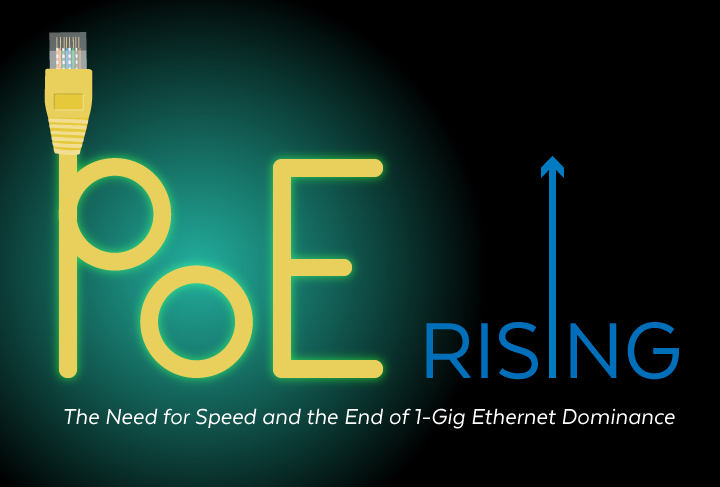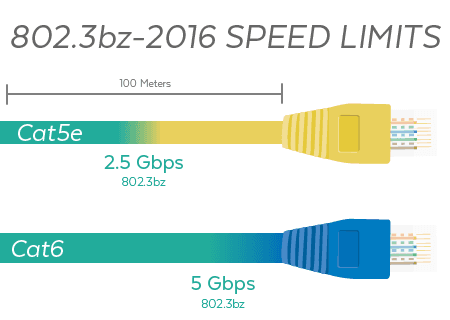A year or so back, an impressive alliance of industry experts including Cisco, Aquantia, Freescale and Xilinx, foresaw the need for faster Ethernet speeds.
But there was a problem.
The cost of jumping from 1Gbps to 10Gbps was too prohibitive. Recabling is expensive and cumbersome. They all wanted to find a better solution.
So they put their heads together and developed an intermediate step–the recently published IEEE 802.3bz.
This new protocol, published in September, is now a reality. At least on paper anyways.
What does it do? Put simply, it allows speeds of either 2.5Gbps over existing Cat 5e cabling or an impressive 5Gbps over existing Cat 6 cables. These speeds are attainable for up to 100 meter (328 feet) lengths and through 10/100/1000T 802.3at ethernet switches.
Though still technically in the laboratory, this protocol will soon begin saving companies a fair deal of money by prolonging the usability of existing infrastructure.
Keep in mind, as exciting as this is, it is still a stop gap. Businesses should absolutely take advantage of this new protocol, but as with all things, infrastructure will eventually need to be upgraded as well.
Ethernet Infrastructure and the IoT
Current speeds achieved over Ethernet twisted pair cabling are slightly over 1 Gbps, generally something in the ballpark of 1.3-1.6Gbps.
These kinds of data speeds work just fine for single user computers. But product innovators are now building for speeds closer to 10Gbps.
To keep up with all of the devices predicted to come online — roughly 20 billion by the year 2020 — companies will need to set aside substantial funds for cable and switch upgrades over the next 3-5 years.
And while they’re at it, companies might also want to take the long view and opt for a 100BASE-T / or even 1000 BASE-T upgrade instead of the modest 10BASE-T.
Happily, the 802.3bz protocol will buy these business owners some time. Here are some of the current power-hungry products.
Ethernet Power Burners
1. The Second Wave of Gigabit Wi-Fi
Interestingly, one place this hardware solution is being called for is in Wave 2 Wifi Technology. That’s because the PHY (physical) data transfer rate is much higher in Wave 2.
The highest speeds Wave 1 PHY can reach is 1.3 Gbps. Wave 2, on the other hand, can go as high as 2.34 Gbps (and even 5Gbps on Cat 6 cables).
When deciding what bandwidth will be most appropriate for your clients, it’s important to consider building in some additional headroom for periods of high demand.
2. High Density for Connected Devices
Wave 2 supports multiuser multiple input, multiple output (MU-MIMO) and therefore offers the potential for greater density of connected devices than Wave 1, and the Spectrum is managed with greater ease.
Spectrum relates to the radio frequencies allocated to the mobile industry and other sectors for communication over the airwaves.
One reason this is really hot has to do with the big cell phone providers like AT&T, Verizon, and T-Mobile. They’ve invested a lot of money in private licenses for Radio Frequency RF Spectrums.
The thing is, there are only so many frequencies available. So, whenever a cell phone user enters a public space like a shopping mall or library, their cell phone automatically searches for and switches to local WiFi, freeing up spectrum frequencies licensed by their carriers.
Incidentally, look for huge WiFi expansion as most of those 20B devices mentioned earlier in the IoT Boom will soon connect over WiFi.
3. Hyper-Convergence Infrastructure
Hyper-convergence is to cloud infrastructure what modular units are to manufactured housing.
Industry leaders are currently building up to 10GbE capacity. According to Serve the Home, 100GbE is the actual number innovation teams are aiming for.
“Hyper-Converged players that still target 10GbE are going to benefit from newer silicon and pricing that will take 10GbE from the big datacenters to even small data closets in more branch offices as power and cooling needs plummet for 10Gbase-T. We expect 2016 to be the year of “whisper quiet” class 10Gbase-T switches with 8+ ports.”
The Future of 1Gbps Ethernet
As the Internet of Things pushes more and more devices to connect to networks, lower power options like the IEEE 802.3bz 2.5/5Gbps over 100 meters/329 feet will definitely continue to hold their place in the ecosystem.
LED lighting is one area where consumers are looking to shave off expenses and low power solutions are in demand.
That being said, ultra-low speed legacy Ethernet infrastructure that only supports 1Gbps may be on its last legs. There will surely still be implementations where it makes sense to leave it in place, but it’s days of dominance are fading into the twilight.
Keep your eyes peeled in the months to come for more information on ever-increasing data speeds and the wide range of accompanying technology making its way to the market.
Also, if you have questions on what steps you can take now to prepare for 802.3bz and the rapid deployment of the Internet of Things, please contact us. One of our engineers will be happy to help.



